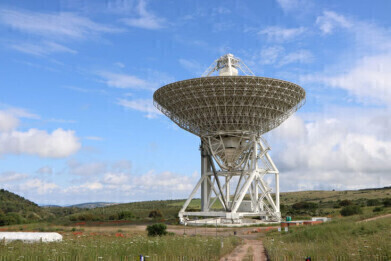-
 Sardinia Radio Telescope (Credit: STFC RAL Space)
Sardinia Radio Telescope (Credit: STFC RAL Space)
News
Enlarging Space Boundaries for Sardinia Observatory
Aug 10 2023
A new receiver that will help observers in Italy to pick up entirely new signals and enhance space weather forecasting has been installed at the Sardinia Radio Telescope based in the Province of Cagliari, by the UK’s Science and Technologies Facilities Council, (STFC).
The Cryogenic Array Receiver for Users of the Sardinia Observatory (CARUSO), designed and constructed by the STFC, RAL Space Millimetre Wave Technology Group (MMT Group), STFC Technology Department and partners from The University of Manchester, uses heterodyne technology to convert and manipulate radio frequencies. This type of signal processing combines two radio frequencies to generate an intermediate frequency, which is generally lower and makes signal processing much more manageable.
The single-dish Sardinia Radio Telescope, approximately half the size of the London Eye, is owned by the Italian National Institute of Astrophysics and has played an important role in astronomical discovery since its construction in 2012. This includes work which has furthered our understanding of black holes and helped track space debris orbiting Earth.
To maximise the information contained within the radio signals received, users in Sardinia have been able to benefit from the RAL Space MMT Group’s expertise of design, development and deployment of millimetre wave instruments such as CARUSO which enable telescopes to pick up more precise signals.
To capture extremely faint radio signals from outer space, the instrument is chilled to a temperature just 20 Kelvin higher than absolute zero, approximately minus 250 degrees Celsius, a temperature achievable through the use of a mechanically cooled cryostat designed and built by the STFC Technology Department.
It is hoped that the new observing modes enabled by CARUSO will allow astronomers to capture images of activity on the sun such as solar flares and aid galactic and extragalactic (beyond the milky way) research, through the increased ability of the Sardinia Radio Telescope to observe cold regions of space including crucial star-forming regions.
Graham Marshall, CARUSO Project Manager at RAL Space said: “I’m really proud of this milestone for the entire CARUSO team. It’s been a huge group effort between ourselves, the University of Manchester, STFC’s Technology group and the Italian National Institute for Astrophysics (INAF), to get this instrument designed, tested and installed onto the telescope and we’re all very excited to hear about the first astronomical observations made. It has been a pleasure working so collaboratively with INAF and I look forward to working on further projects in the future.”
Further information online
Digital Edition
Lab Asia Dec 2025
December 2025
Chromatography Articles- Cutting-edge sample preparation tools help laboratories to stay ahead of the curveMass Spectrometry & Spectroscopy Articles- Unlocking the complexity of metabolomics: Pushi...
View all digital editions
Events
Jan 21 2026 Tokyo, Japan
Jan 28 2026 Tokyo, Japan
Jan 29 2026 New Delhi, India
Feb 07 2026 Boston, MA, USA
Asia Pharma Expo/Asia Lab Expo
Feb 12 2026 Dhaka, Bangladesh


















